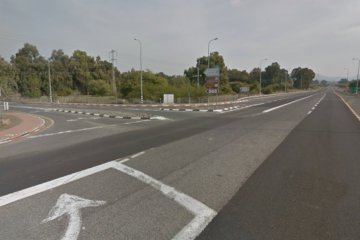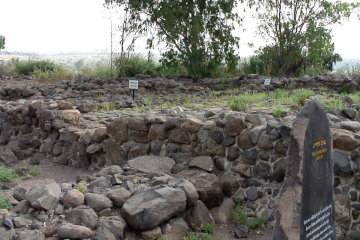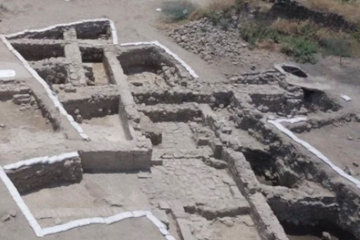The Real Bethsaida?
When we take a tour group to Palestine we always arrange a boat trip across the Lake of Galilee. At one time there was a regular ferry from Tiberias to Ein Gev and this was our preferred option, but when the ferry ceased we had to make other arrangements, usually with a local fisherman willing to earn a few dollars extra. Then came the discovery of the 1st century AD boat at Kibbutz Ginosar and some local entrepreneur decided to cash in by making a "replica" of the boat on which tourists could ride.
The original boat was just barely big enough for twelve men, which led some to call it "the Jesus boat" - there is no other conceivable connection between the Ginnosar boat and Jesus of Nazareth. The modern "replicas", also called "Jesus boats" just happened to be big enough to accommodate 52 persons - the same number as a tourist coach! The idea caught on and there are now some half a dozen "Jesus boats" plying the waters of Lake Galilee, transporting tourists from one side to the other or for cruises from Tiberias to - say - Capernaum.
Our preferred route is to board our bus in Tiberias and head north, past Magdala, home of Mary of that name, and on to Kibbutz Ginnosar, where we view the genuine "Jesus boat". At one time all you could see was a faint outline as the timbers were immersed in a cloudy and opaque preserving solution. Now that the solution has done its work, the boat is displayed inside a large room.
It is clear that timber was in short supply in the first century AD, as the ribs of the boat are a collection of crooked tree branches. If St Peter's boat was anything like this, Jesus must have been tired indeed to fall asleep in the discomfort of these ribs! Also notable is the fact that there is no trace of a "step", a block of timber with a hole in it which served to locate the foot of a mast (the actual strain of holding a mast upright was, of course, taken by the rigging).
According to the Talmud - not always a reliable source of historical information - boats on Galilee were not allowed to have sails.
It is permitted to fish with an angle in the Sea of Tiberias, provided that no sail is spread, as this would detain boats. Our Rabbis taught, "The tribes stipulated with one another at the very outset that nobody should spread a sail and thus detain boats."
Talmud: Tractate Baba Kama
I'm not sure how a sail would "detain" a boat, but it is interesting that in the Gospel accounts of the storm on Galilee John specifically states that the disciples "rowed" - and probably, as the youngest, John had more than his fair share of the rowing! So much for all the pictures showing Jesus walking on the water towards a boat with a billowing sail!
From Ginnosar we continue on round the lake to Tabgha where there is a large church covering an ancient mosaic depicting bread and fish, believed to be a reference to Jesus' miracle when He divided five loaves and two small fish among a crowd of 5,000 men. Even more interesting, in my opinion, is a large mosaic depicting the Nile and its fauna and flora. This seems to be somewhat unusual decoration for a church but was not uncommon in a private house, arguing that whatever the archaeologist-monks uncovered, it wasn't a church built over the very spot of the miracle.

| |
| Moses' Seat in the synagogue at Chorazin. |
When I am in charge of the group I then direct the bus up the hill to Chorazin, where you can walk around among the ruins of houses built of black basalt and get an idea of what Capernaum must have been like. In addition just inside the synagogue there is an ornate chair, believed to be the "Moses' seat" to which Jesus referred in His condemnation of the pharisees. Like modern Muslims, Jewish preachers sat - it was the Greeks and Romans who introduced the idea of standing to speak - and such a chair would indicate the authority of the speaker.
Capernaum is next on our list - and I would gladly leave it off, but everyone expects to go there because the Gospels refer to it as "Jesus' city", the place He made His home after leaving Nazareth. Little remains of the houses beyond the foundations, the impressive synagogue dates from a century or so after Christ, and the only moderately interesting sight - the foundations of a house over which an octagonal church had been built - has been disfigured by a concrete monstrosity that looks like a Star Wars flying saucer. This archtechtural abomination is due to the Franciscan desire to build a church over the "actual house of St Peter" - which is visible through a large hole in the floor of the space ship.
From there we head round the north end of the lake, past the point where the Jordan River flows into the lake, and on to Kursi, where a Byzantine monastery marked the "very spot" where Jesus cast the demons out of a demoniac and allowed them to enter a nearby herd of pigs, which promptly ran down a cliff into the lake and were drowned. It is true that about half a mile away there is a sort of cliff along the lake side - six feet high if it is an inch. The Greek word simply means a steep place, not necessarily a vertical cliff, and there are other more likely spots for the miracle, which took place close enough to a city for there to be tombs among which the demoniac could wander. There is no cemetery at Kursi because the place did not exist in Jesus' day!
From there it is a short stretch to Ein Gev, where we abandon the bus and board a boat for the trip back to Tiberias. A very pleasant way to end the day, with sufficient time left over for people to hit the souvenir shops in Tiberias if that is their wish.

| |
| The turn-off to the official Bethsaida national park. |
We had followed this circuit I don't know how many times when one year no one had asked me a question and I was free to sit behind the driver and observe the road. Just beyond the influx of the Jordan, we passed a brown tourist sign on the left and pointing to the left and I caught a glimpse of the name "Bethsaida". I remarked on this to our guide, who told me that it was just a nature reserve, that you had to pay a fee to enter and it was not included in the itinerary, so I would have to stump up 52 entry fees if we wanted to visit it. Knowing nothing of the place - apart from the fact that it is mentioned in the Bible - I indicated that my interest was luke warm and we passed on to Kursi.
Two years later I had occasion to drive round Galilee in a hire car and without a tour group, so I stopped and visited Bethsaida. The woman at the ticket office spoke excellent English and informed me that there was nothing to see apart from a shaded picnic area. I thanked her and went on my way without forking out the couple of shekels for entry.

| |
| The House of the Fisherman at et-Tel, so called from the objects found in the ruins. |
Two years after that I happened to notice that Bethsaida was now included in the sort of season ticket we purchase for each of our group members and which gives you discounted entry to a whole raft of ancient sites and national parks. I therefore took the group into the park and discovered that in the interim there had either been excavations or the excavations had happened some time previously but the site had only just been tidied up and made suitable for visitors. There was a tel, on top of which were some ruins, including the foundations of one house labelled "The Fisherman's House". There was also a putative ruin of a church, but once you had viewed those stones you had exhausted the entertainment potential of the place.

| |
| An artist's reconstruction of the House of the Fisherman on an information panel. |
What the information boards on the tel did not mention was that the place may not be Bethsaida at all! Known as et-Tel, the remains seem to fit the recorded history of Bethsaida, right down to being abandoned in the third century AD following an earthquake. The main problem is that et-Tel is nearly two miles from the shore of Galilee. The boards suggest that the lake may have been closer in the first century than it is today, but even so it must have been more like a shallow marsh.
There is, in fact, another site, el-Araj, which is on the eastern bank of the Jordan a mere 650' from where it empties into the Lake of Galilee. Excavations there have uncovered remains that also seem to fit the recorded history of Bethsaida. Unfortunately, the site is somewhat waterlogged because, so the excavators claim, the modern level of the lake is higher than it was in the first century AD!
Actually, both claims regarding the level of the lake may be correct. If you look at an aerial view of the area there is low-lying farm land in a bay in the hills which surround Galilee. As well as the Jordan, there are at least three other watercourses that empty into this bay and which will have carried down quantities of silt that have filled the bay making the modern shoreline very different from what it may have been in Jesus' day. If so, then first century el-Araj may have been little more than a mound in the marsh.
The disciple John mentions Bethsaida twice as the home town of Philip, but in the first reference he adds some extra information. "Now Philip was of Bethsaida, the city of Andrew and Peter." (John 1:44) Peter is more usually associated with Capernaum - it was near Capernaum that Jesus first met him and called him to become a "fisher of men", it was in Capernaum that Jesus healed Peter's mother-in-law, and so on. It is natural to assume that Capernaum was Peter's home town, but wherever he happened to have settled down, it would appear that he came from Bethsaida. If, as I suggest, el-Araj was so low-lying - and if el-Araj is the genuine Bethsaida - it is no wonder the Peter and his family moved to Capernaum; the fishing was better and the surroundings were healthier.
Unfortunately our early documents do not make it possible to decide between the two claimants. For example, Willibald, bishop of Eichstatt and the first known Englishman to visit the Holy Land, records his visit to the area.
And they came to that village, Capharnaum, where our Lord raised to life the ruler's daughter; and there is a house and a thick wall. And the men there said that Zebedee, with his sons John and James, had been lodged therein. And thence they proceeded to Bethsaida, whence came Peter and Andrew. There is now a church where their house was formerly. They stayed there one night, and, in the morning, went on to Corozain, where our Lord cured the demoniacs, and sent the devil into the herd of swine. There was a church of the Christians.
In other words, Bethsaida is between Capernaum and Kursi (Corozain) - which is true of both sites.

| |
| The proposed Byzantine church at el-Araj |
Back in 2021 archaeologists Mordechai Aviam and Steven Notley excavated a Byzantine church in el-Araj which they named the "Church of the Apostles". Like other buildings of the period, the floor of the church is made of crude mosaic where black and white stones form a rough floral pattern. In several places the pattern is interrupted by circles - roundels - within which there are mosaic inscriptions. Such inscriptions usually give us the name of the person who paid for the mosaic.
In the sacristy the excavators found another roundel with a lengthy inscription, naming "Constantine, the servant of Christ" as the donor. It also offers a petition to "the chief and commander of the heavenly apostles", a Byzantine title applied exclusively to Peter. It is little enough to go on, for any church in any location may contain a prayer to any of the saints, but Aviam and Notley have no doubts that the inscription proves that their church was built - as Willibald says - over the home of Peter and his brother.
It would be just too funny if further inscriptional evidence were to demonstrate that both sites are "Bethsaida" - one being the village and the other the port.
Those interested in the excavations can visit the official website of the al-Araj project.
© Kendall K. Down 2022





